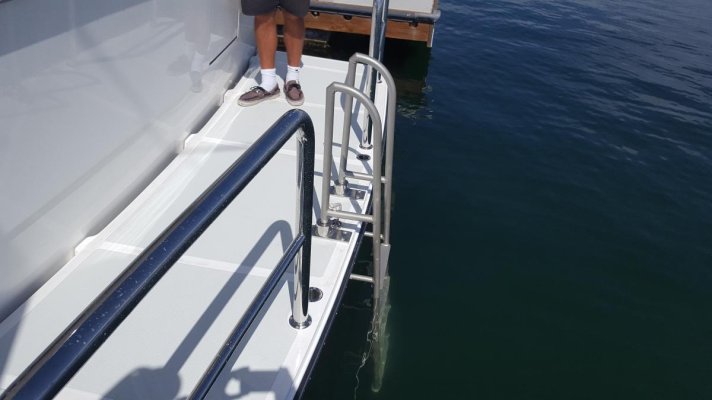SAFETY LADDERS
Planning and Design Guidelines for Small Craft Harbors, ASCE Manuals and Reports on Engineering Practices No. 50:
“Ladders are generally provided on fixed and floating docks to allow emergency access from the water. In addition, where the tide range and fixed piers may not provide convenient berthing access at all tidal stages, ladders are also provided adjacent to the berths (from the finger piers). According to the requirements of UFC 4-152-01 (NAVFAC 2005), ladders to provide access to fixed piers (or floating docks) from the water should be provided at a maximum spacing of 120 m (400 ft) on centers [sic] or within 60 m (200 ft) of any work area.
Ladders should be a minimum of 406 mm (16 in.) wide and reach the lowest water elevation anticipated. Retractable or flip ladders may be used as an alternative to fixed ladders to avoid marina fouling of the lower steps, but they can be difficult for a swimmer to reach and pull down in case of an emergency. There are numerous commercially available ladders made typically of marine-grade aluminum or stainless steel.”
Various forms of “lifting ladders” are convenient for floating docks, where they can be kept in the retracted position until needed. For recreational small craft harbors, ladders are generally spaced according to the management’s anticipated needs, clientele usage, and safety plan. They are often placed at the ends of T-heads of finger piers (so as to not affect berthing in the slips), in fairways, or adjacent to bulkheads so that anyone who may fall into the water can easily swim to a ladder without crossing under or through piers and vessels or across main navigable waterways.”
California Code of Regulations: #4405. Working Over Water:
(a) – “Permanently installed or portable ladders available for emergency use shall be provided on all waterfront docks.
Such ladders shall extend from the face of the dock to the water line at its lowest elevation;
Spacing between ladder installations shall not exceed 400 feet; and
The ladder shall be secured to the dock or pier before use.”
29 CFR 1917.26 (f) First Aid and lifesaving facilities:
“A readily available portable or permanent ladder giving access to the water shall also be provided within 200 feet (61 m) of such work areas.”
National Park Service Marina Standards 2016:
“Access ladders are well-maintained and secured, and appropriately located throughout the marina.”
Safety and Health in Ports, International Labour Office, Quayside Ladders, section 3.3.5:
“Permanent ladders should be provided at the edge of any structure in a port from which persons may fall into deep water to enable them to climb out of the water.”
“Ladders should be spaced at intervals of not more than 50 m (164 ft) from each other or from steps.”
Unified Facilities Criteria (UCF), Design: Piers and Wharves: 7-9.1 Safety Ladders.
“Provide safety ladders from pier or wharf deck to water at a maximum spacing of 400 feet (122 m) or as noted below with regard to life rings. Such ladders should be at least 1 foot 4 inches (0.41 m) wide and should reach to the lowest water elevation anticipated.”
PIANC RecCom WG Report n° 149/part IV – 2017: Guidelines for Marina Design:
“Ladders should be located along quay walls, fixed piers, pontoons, and in whatever place where they could be useful for safety, at a distance of not more of 50 m from each other.”
FURTHER NOTES ON LIFE RINGS AND SAFETY LADDERS
Other interesting notes concerning life rings and safety ladders:
California Code of Regulations: #4405. Working Over Water:
“The dock area immediately adjacent to ladder locations shall be painted a contrasting bright color.”
Safety and Health in Ports, International Labour Office, Quayside Ladders, section 3.3.5:
“Ladders from the water should be conspicuous so as to be easily seen by anyone falling into the water. The tops of the ladder should be clearly visible to persons on the quayside.”
Unified Facilities Criteria (UCF), Design: Piers and Wharves: 7-9.2 Life Rings.
“Co-locate life rings with permanent ladders.”




![IB00633737[1].jpg](/data/attachments/71/71639-3bca82b626a13c5e06464230dbd7f229.jpg)
![IB00633687[1].jpg](/data/attachments/71/71640-905033e392bc0461250b583fde0a9799.jpg)

